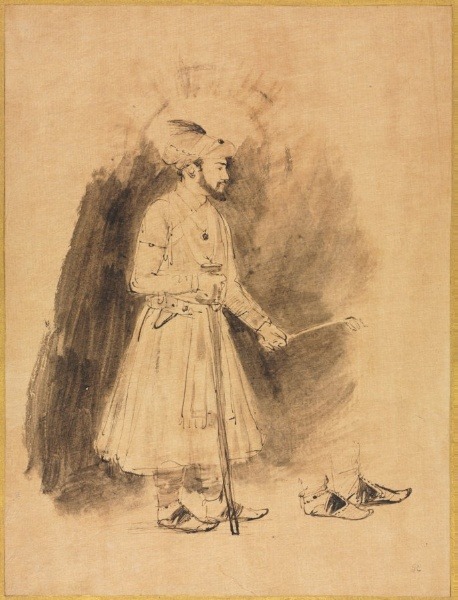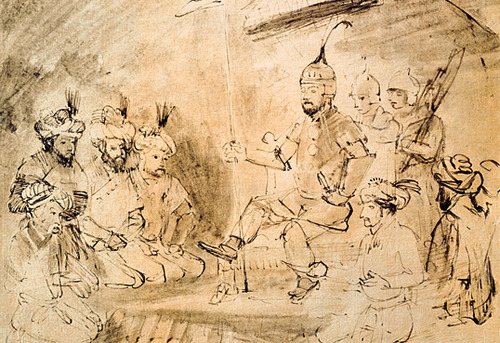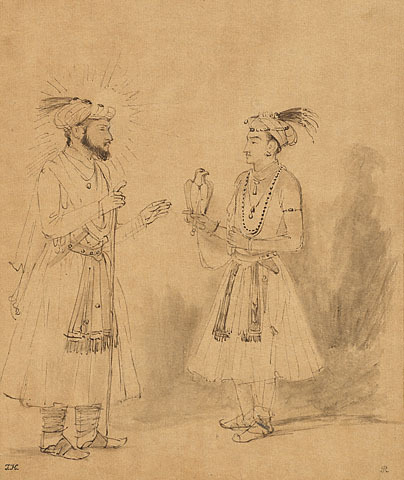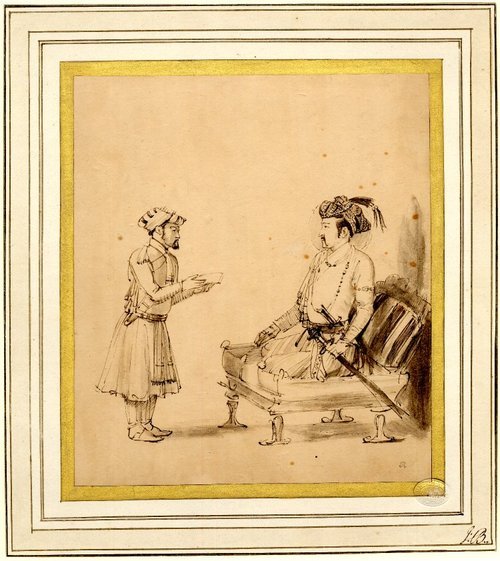In the 17th century, Rembrandt made a set of etchings of people garbed in clothes uncannily similar to the north Indian attire of the time.

Four Orientals seated under a tree, c 1656-1661
Photo credit: British Museum
How did he, who never set foot out of the Dutch Republic know what “orientals” wore?

A Mughal nobleman on horseback, c 1656-1661
Height: 205 millimetres, Width: 177 millimetres
Height: 205 millimetres, Width: 177 millimetres
Photo credit: British Museum
A Mughal nobleman on horseback; after a Mughal miniature, a man, with slight beard, holding a two-headed lance seated on a horse which is rearing to right. c.1656-1661
Pen and brown ink with brown and grey wash, touched with red and yellow chalk and white heightening and with some scraping-out, on oriental paper; the lance drawn with a ruler.

Indian Prince as Warrior, c. 1655
Brown ink, brown wash, black chalk and white opaque watercolor on Asian paper; later additions in gray wash and scratchwork, framing line in brown ink
18 x 7.3 cm (7 1/16 x 2 7/8 in.)
Brown ink, brown wash, black chalk and white opaque watercolor on Asian paper; later additions in gray wash and scratchwork, framing line in brown ink
18 x 7.3 cm (7 1/16 x 2 7/8 in.)
Photo credit: Fogg Museum of Art
Mughal miniatures might have made their way to the damp and distant home of the Dutch painter.

A Mughal nobleman on horseback
At the Louvre

Rembrandt Harmenszoon Van Rijn
A Mughal Nobleman standing, 1656-1661 (circa)
paper Drawing
Height: 184 millimetres, Width: 112 millimetres
British Museum
 Rembrandt Harmenszoon Van Rijn
Rembrandt Harmenszoon Van Rijn
Shah Jahan, Netherlands (1654-56)
Pen and brown ink and brush and brown wash on Japanese paper.
Cleveland Museum of Art
 Rembrandt Harmenszoon Van Rijn
Rembrandt Harmenszoon Van Rijn
The Emperor Timur Enthroned, (1654-56)
Pen and wash in Indian ink on Japanese paper.
Musée du Louvre, Paris
_large.jpg)
Rembrandt Harmenszoon Van Rijn
The Emperor Akbar and his Son Selim in Apotheosis, Leiden 1606
pen and brown ink, brown wash, corrected with white bodycolour
212 x 174 mm
Stichting Museum Boijmans Van Beuningen

Rembrandt Harmenszoon Van Rijn
Shah Jahan and Dara Shikoh, 1654-1656
Pen and brown ink and brown wash
Japanese paper
8 3/8 x 7 in.
The J. Paul Getty Trust, Los Angeles
 Rembrandt Harmenszoon Van Rijn
Rembrandt Harmenszoon Van Rijn
Two Mughal noblemen, 1656-1661 (circa)
Pen and brown ink with brown and grey wash
Height: 172 millimetres, Width: 214 millimetres
British Museum

Emperor Jahāngīr receiving an Officer. c.1656
paper Drawing
Height: 210 millimetres, Width: 184 millimetres
British Museum
_large.jpg) An Indian Lady, after a Mughal Miniature, 1656
An Indian Lady, after a Mughal Miniature, 1656
Pen and brown ink on oriental paper
79 x 72 mm
Stichting Museum Boijmans Van Beuningen

Shah Jahan, debout avec une fleur et une epee
Shah Jahan, Standing with a Flower and a Sword (1654-56)
Pen and brown ink with brown wash on Japanese paper.
The Frick Collection, New York

Rembrandt Harmenszoon Van Rijn
A Deccani Nobleman standing; 1656-1661 (circa)
Pen and brown ink with grey and brown wash
oriental paper
Height: 196 millimetres, Width: 158 millimetres
British Museum


Rembrandt Harmenszoon Van Rijn
A Mughal Nobleman standing, 1656-1661 (circa)
paper Drawing
Height: 184 millimetres, Width: 112 millimetres
British Museum
A Mughal Nobleman standing; after a Mughal miniature, whole-length, almost in profile to right, his right hand on the handle of a dagger in his belt. c.1656-1661
Pen and brown ink with grey and brown wash, touched with red chalk (in the turban) and white heightening, on oriental paper.

Shah Jahan, Netherlands (1654-56)
Pen and brown ink and brush and brown wash on Japanese paper.
Cleveland Museum of Art
Between 1656 and the early 1660s Rembrandt copied twenty-five drawings from contemporary miniatures from the Mughal Empire.

The Emperor Timur Enthroned, (1654-56)
Pen and wash in Indian ink on Japanese paper.
Musée du Louvre, Paris
These are fifteen drawings of twenty-five he made.
_large.jpg)
Rembrandt Harmenszoon Van Rijn
The Emperor Akbar and his Son Selim in Apotheosis, Leiden 1606
pen and brown ink, brown wash, corrected with white bodycolour
212 x 174 mm
Stichting Museum Boijmans Van Beuningen
These drawings echoed in his later works, in turban styles and the drape and texture of certain fabrics. These were a part of a larger movement to represent Biblical scenes as happening in a non-European world.

Rembrandt Harmenszoon Van Rijn
Shah Jahan and Dara Shikoh, 1654-1656
Pen and brown ink and brown wash
Japanese paper
8 3/8 x 7 in.
The J. Paul Getty Trust, Los Angeles
Mughal Emperor Shah Jahan (r.1627-58) with a walking stick and his eldest and favorite son, Dara Shikoh holding a falcon. Shah Jahan is perhaps best known as the builder of the Taj Mahal, which was a tomb for his beloved wife, Mumtaz.

Two Mughal noblemen, 1656-1661 (circa)
Pen and brown ink with brown and grey wash
Height: 172 millimetres, Width: 214 millimetres
British Museum
Two Mughal noblemen; after a Mughal miniature, the man at right with a beard facing a younger, clean-shaven man, both wearing turbans and holding long swords.
Pen and brown ink with brown and grey wash, touched with white and with scraping-out, on oriental paper prepared with pale brown wash; traces of framing lines in pen and pale brown ink visible towards the right of the lower edge; an accidental graphite mark below right figure.

Emperor Jahāngīr receiving an Officer. c.1656
paper Drawing
Height: 210 millimetres, Width: 184 millimetres
British Museum
Emperor Jahāngīr receiving an Officer; copy after a Mughal miniature, the Emperor, with halo, seated on a divan with a sabre in his left hand, a man holding a document standing before him at left. c.1656-1661
Pen and brown ink, with brown and grey wash, touched with white, on oriental paper.
_large.jpg)
Pen and brown ink on oriental paper
79 x 72 mm
Stichting Museum Boijmans Van Beuningen

Shah Jahan, debout avec une fleur et une epee
Shah Jahan, Standing with a Flower and a Sword (1654-56)
Pen and brown ink with brown wash on Japanese paper.
The Frick Collection, New York

Rembrandt Harmenszoon Van Rijn
A Deccani Nobleman standing; 1656-1661 (circa)
Pen and brown ink with grey and brown wash
oriental paper
Height: 196 millimetres, Width: 158 millimetres
British Museum
A Deccani Nobleman standing; after a Mughal miniature, whole-length, almost in profile to left, with moustache and slight beard, his left hand leaning on a sword, his right extended. c.1656-1661
Pen and brown ink with grey and brown wash and scraping-out on oriental paper prepared with pale brown wash.

Mughal



No comments:
Post a Comment